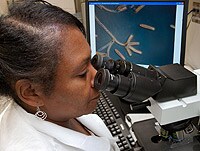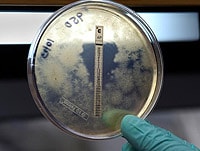Changing Clinical Picture of Meningitis Outbreak
Drug & Reference Information
More than 2 months after the 3 lots of injectable methylprednisolone acetate (MPA) produced by the New England Compounding Center (NECC) were implicated in the fungal meningitis outbreak and recalled, the Centers for Disease Control and Prevention (CDC) continues to receive reports of fungal meningitis and other infections in exposed patients, the CDC said today.
"As of November 26, a total of 510 cases, including 36 deaths, have been reported in 19 states," reported Melissa K. Schaefer, MD, medical officer, Division of Healthcare Quality Promotion, National Center for Emerging and Zoonotic Infectious Diseases, CDC, during a Clinician Outreach and Communication Activity (COCA) call, the fourth COCA call since the outbreak began.
Exserohilum rostratum continues to be the predominant fungus identified in patients and confirmed by the CDC laboratory. Previously, the majority of cases reported to CDC were of patients with fungal meningitis after injection with contaminated MPA, noted John Jernigan, MD, who is also a medical officer in the Division of Healthcare Quality Promotion, National Center for Emerging and Zoonotic Infectious Diseases at CDC.
And although cases of fungal meningitis continue to be reported, CDC is "seeing a transition in the clinical presentation of the cases that are being reported," he said.
"We have recently observed an increase in the number of patients presenting with evidence of epidural abscess, phlegmon, discitis, vertebral osteomyelitis, or arachnoiditis at or near the site of injection and we see these complications occurring in patients both with and without evidence of fungal meningitis," Dr. Jernigan said.
A Transition in Clinical Presentation
According to CDC, of the 91 cases reported to CDC since November 4, 26 (29%) were classified as meningitis, 61 (67%) had spinal or paraspinal epidural abscess or osteomyelitis, 2 (2%) had peripheral joint infection, and 2 (2%) had more than 1 condition.
"It's important to note that the overall trend in the number of cases being reported is still going down; it's just that a larger proportion of those that are being recently reported are some of these paraspinal or spinal infections," Dr. Jernigan said.
Patients with these localized infections frequently have new or worsening back pain. Yet, it's "important to note that the symptoms may in fact be quite mild or very clinically difficult to distinguish from the patient's baseline chronic pain that called for the injection in the first place," Dr. Jernigan said.
He said the CDC's current diagnostic and treatment guidance addresses management of patients with epidural abscess or other complications at or near the injection site.
On the basis of current information, the CDC recommends the following diagnostic protocol:
- In patients with new or worsening symptoms at or near the injection site, physicians should obtain an MRI with contrast of the symptomatic areas, if not contraindicated. This recommendation also applies to patients being treated for meningitis. In some cases, radiologic evidence of abscess or phlegmon has become apparent on repeat MRI studies performed after an initially normal imaging procedure. Clinicians should therefore have a low threshold for repeat MRI studies in patients who continue to have symptoms localizing to the site of injection, even after a normal study result. However, the optimal duration between MRI studies is unknown.
- CDC has received reports of patients being treated for fungal meningitis who had no previous evidence of localized infection at the site of injection but who were subsequently found to have evidence of localized infection (eg, epidural abscess, phlegmon, discitis, vertebral osteomyelitis, or arachnoiditis) on imaging studies. Therefore, in patients being treated for meningitis, even in the absence of new or worsening symptoms at or near the injection site, clinicians should strongly consider obtaining an MRI of the injection site approximately 2 to 3 weeks after diagnosis of meningitis. Early identification of new disease may facilitate additional specific interventions (eg, drainage) and provide information for measuring effectiveness of therapy thereafter.
- For patients demonstrated to have epidural abscess, phlegmon, discitis, vertebral osteomyelitis, or arachnoiditis, early consultation with a neurosurgeon to discuss whether surgical management, including debridement, is warranted in addition to antifungal therapy. For information about antifungal therapy, see Interim Treatment Guidance for Central System and Parameningeal Infections Associated with Injection of Contaminated Steroid Products.
Clinician Consultation Network
The CDC has set up a Clinician Consultation Network to assist clinicians managing patients with fungal meningitis and other infections associated with contaminated MPA injection.
This is a "network of infectious disease experts who have special expertise in treating fungal infections who are being made available through the CDC to clinicians who are caring for patients involved in this outbreak if they need additional assistance or additional information on individual patient management," Dr. Jernigan said.
To access the Clinician Consultation Network and be put in touch with an expert, clinicians can call 1-800-CDC-INFO.
Medscape Medical News © 2012 WebMD, LLC

